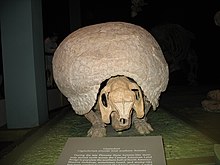 Global Information
Global InformationGlyptotherium information
| Glyptotherium Temporal range: Early Pliocene-Late Pleistocene (Blancan-Rancholabrean) (Ensenadan-Lujanian)
~ | |
|---|---|

| |
| G. texanum, National Museum of Natural History | |
| Scientific classification | |
| Domain: | Eukaryota |
| Kingdom: | Animalia |
| Phylum: | Chordata |
| Class: | Mammalia |
| Order: | Cingulata |
| Family: | Chlamyphoridae |
| Subfamily: | †Glyptodontinae |
| Genus: | †Glyptotherium Osborn, 1903 |
| Type species | |
| †Glyptotherium texanum Osborn, 1903
| |
| Other Species | |
| |

| |
| Distribution of Glyptotherium (orange) compared to Glyptodon's (green). | |
| Synonyms | |
Synonyms of G. texanum
Synonyms of G. cylindricum
| |
Glyptotherium (from Greek for 'grooved or carved beast') is a genus of glyptodont (an extinct group of large, herbivorous armadillos) in the family Chlamyphoridae (a family of South American armadillos) that lived from the Early Pliocene, about 3.6 million years ago, to the Late Pleistocene, around 15,000 years ago. It had a wide distribution, living in the United States, Mexico, Guatemala, Costa Rica, Honduras, El Salvador, Panama, Venezuela, and Brazil. The genus was first described in 1903 by American paleontologist Henry Fairfield Osborn with the type species being, G. texanum, based on fossils that had been found in the Pliocene Blancan Beds in Llano Estacado, Texas, USA. Glyptotherium fossils have since been unearthed from many more fossil sites, from Florida to Colombia. Another species, G. cylindricum, was named in 1912 by fossil hunter Barnum Brown on the basis of a partial skeleton that had been unearthed from the Pleistocene deposits in Jalisco, Mexico. The two species differ in several aspects, including age, with G. texanum being from the older Early Pliocene to Early Pleistocene strata, whereas G. cylindricum is exclusive to the Late Pleistocene.
Glyptotherium was a large, quadrupedal (four-legged), herbivorous armadillo with an armored carapace (top shell) that was made of hundreds of interconnected osteoderms (structures in dermis composed of bone). Other pieces of armor covered the tail and cranium roof, the skull being tall with hypsodont (high-crowned) teeth. As for the postcranial anatomy, pelves fused to the carapace, an amalgamate vertebral column, short limbs, and small digits are characteristic of Glyptotherium and its relatives. Glyptotherium reached up to 2 meters (6.56 feet) long and 400 kilograms (880 pounds) in weight, making it one of the largest glyptodonts but not as large as its close relative Glyptodon or Doedicurus, the largest known glyptodont. Glyptotherium is morphologically and phylogenetically most similar to Glyptodon, however they differ in several ways. Glyptotherium is smaller on average, with a shorter carapace, a relatively longer tail, and a slender zygoma, or cheek bone.
Glyptodonts evolved first during the Eocene, but greatly diversified in the Miocene and Pliocene, largely in the Santacrucian sites of Argentina. However, their diversity diminished into the Pleistocene, though they peaked in size during this period. Glyptotherium is considered an example of North American megafauna, of which most have become extinct, and may have been wiped out by changing climate or human interference. Glyptotherium was primarily a grazer, but also had a mixed diet of fruits and other plants, that lived on open grasslands. The armor could protect the animal from predators, of which many coexisted with Glyptotherium during its existence, including the "saber-tooth cat" Smilodon, the "bone-crushing dog" Borophagus, and the "short-faced bears" (Tremarctinae).